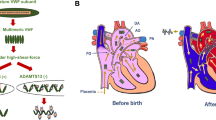Summary
Intra and extraembryonic hemorrhages were caused in chick embryos of 44–52 hours, in order to study the influence of these hemorrhages on embryonal malformations.
The intraembryonic hemorrhages, produced by aortic punction, caused malformations in 26% of the cases, and the extraembryonic hemorrhages (induced by section of a branch of the omphalomesenteric vein) in 8% of the cases.
The lfmaormations affected principally the skeleton of the trunk. When thes emalformations were studied in the initial stages of the embryo, it was apparent that one or two somites were smaller than their neighbours or, if the hemorrhage was more intensive, a fusion of two somites could be observed.
In the embryos of 8–10 days it was possible to observe a complete series of vertebral malformations. The ribs, as well, presented diverse malformation. However, these malformations of the ribs were not necessarily correlated with those of the vertebrae.
Apart from the alterations in the thoracic and lumbar regions, in four cases a very short tail composed of indiferenciate mesodermal tissue, was apparent.
The significance of these malformations, with respect to normal developpment, is discussed.
Zusammenfassung
Die Versuche der vorliegenden Arbeit zeigen, daß die Blutungsanämie eine Ursache embryonaler Mißbildungen sein kann. Das Rumpfskelet ist auf das Schwerste betroffen. Wenn die Störungen in den ersten Stadien betrachtet werden, sieht man einen oder zwei Somiten, die kleiner sind als ihre Nachbarn, oder es entsteht eine Somitenfusion, wenn die Störung schwerer ist. In fortgeschrittenen Stadien beobachtet man eine ganze Reihe von Wirbel- und Rippenfehlern.
Vier Fälle zeigten außer schweren Störungen im thorakolumbalen Abschnitt einen sehr kurzen Schwanz, der nur undifferenziertes, mesodermales Gewebe enthielt. Die Bedeutung dieser Mißbildungen für die normale Entwicklung wird diskutiert.
Similar content being viewed by others
Literatur
Bühner, F. M.: Differenzierungsstörungen im mittleren und hinteren Körperdrittel des Hühnchens nach experimentellem Sauerstoffmangel in der Frühentwicklung. Beitr. path. Anat. 115, 616–643 (1955).
Degenhardt, K. H., and E. Knoche: Analysis of intrauterine malformations of the vertebral column induced by oxygen deficiency. Canad. med. Ass. J. 80, 441–445 (1959).
Dietsche, A.: Differenzierungsstörungen am Rückenmark des ausgebrüteten Hühnchens nach kurzfristigem Sauerstoffmangel in der Frühentwicklung. Beitr. path. Anat. 115, 599–616 (1955).
Hicklin, A.: Die Wirkung des kurzfristigen Sauerstoffmangels auf 72-stündige Hühnerembryonen. Wilhelm Roux' Arch. Entwickl.-Mech. Org. 153, 262–282 (1961).
Ingalis, T. B., F. J. Curley, and R. A. Prindle: Experimental production of congenital anomalies (timing and degree of anoxia as factors causing fetal deaths and congenital anomalies in the mouse). New Engl. J. Med. 247, 758–768 (1952).
Lecyk, M.: The effect of hyperthermia applied in the given stages of pregnancy on the number and form of the vertebrae in the offspring of white mice. Experientia (Basel) 21, 452–453 (1965).
—: The effect of hypothermia applied in the given stages of pregnancy on the number and form of vertebrae in the offspring of white mice. Experientia (Basel) 22, 254–255 (1966).
Murakami, U., and Y. Kameyama: Vertebral malformations in the mouse foetus caused by maternal hypoxia during early stages of pregnancy. J. Embryol. exp. Morph. 11, 107–118 (1963).
Mushett, C. W.: Differenzierungsstörungen des Zentralnervensystems am Hühnerkeim nach kurzfristigem. Sauerstoffmangel. Beitr. path. Anat. 113, 367–387 (1953).
Naujoks, H.: Der Einfluß kurzfristigen Sauerstoffmangels auf die Entwicklung des Hühnchens in den ersten fünf Bruttagen. Beitr. path. Anat. 113, 221–252 (1953).
Ruebsaamen, H.: Über die teratogenetische Wirkung des Sauerstoffmangels in der Frühentwicklung. Beitr. path. Anat. 112, 336–379 (1952).
Russel, L. B.: Abnormalities of the vertebral column and thorax. J. exp. Zool. 113, 329–396 (1956).
Smithberg, M.: Teratogenic effects of some hypoglycemic agents in mice. Anat. Rec. 136, 280 (Abstr.) (1960).
Spratt Jr., N. T.: Nutritional requirements of the early chick embryos. J. exp. Zool. 114, 375–402 (1950).
Theiler, K.: Störungen der Ursegmentbildung durch mutierte Gene bei der Hausmaus. Arch. Klaus-Stift. 31, 285–290 (1956).
—: Metameriestörungen und ihre Konsequenzen im Säugetierexperiment. Z. Anat. Entwickl.-Gesch. 126, 31–42 (1967).
Thorn, W.: Dynamik des Zellgeschehens und Ursachen für Gewebsuntergang im Sauerstoffmangel. Dtsch. med. Wschr. 85, 74–78 (1960).
Author information
Authors and Affiliations
Additional information
Colaborador Científico del Consejo Superior de Investigaciones Científicas (Madrid)
Für die Anregungen und für die Hilfe in der deutschen Abfassung danke ich Herrn Prof. K. Theiler bestens.
Rights and permissions
About this article
Cite this article
Gonzalo-Sanz, L.M. Blutungsanämie als Ursache embryonaler Mißbildungen. Z. Anat. Entwickl. Gesch. 126, 355–360 (1968). https://doi.org/10.1007/BF00520800
Received:
Issue Date:
DOI: https://doi.org/10.1007/BF00520800




